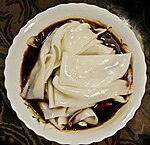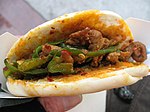This article needs additional citations for
verification. (June 2017) |
| Shaanxi cuisine | |||||||
|---|---|---|---|---|---|---|---|
| Traditional Chinese | 陝西菜 | ||||||
| Simplified Chinese | 陕西菜 | ||||||
| |||||||
| Qin cuisine | |||||||
| Chinese | 秦菜 | ||||||
| |||||||
| Part of a series on |
| Chinese cuisine |
|---|
 |
Shaanxi cuisine, or Qin cuisine, is derived from the native cooking styles of Shaanxi Province and parts of northwestern China.
Description
Shaanxi cuisine makes elaborate use of ordinary materials, and is characterized by its noodles, lamb/mutton dishes, and heavy use of strong and complex flavours. There is an emphasis on savoury flavours such as salt, garlic, onion and vinegar; sugar is seldom used. The main cooking methods are steaming, frying and stir-frying.
Due to its geographical location between the provinces of Shanxi and Sichuan, the flavours of Shaanxi cuisine include both the sour and spicy of Sichuan cuisine, and the salty flavours of Shanxi. Shaanxi cuisine's primary flavor profile is xiāng là (香辣) or "fragrant spicy".
Shaanxi cuisine uses more noodles than other Chinese cuisines, but Shaanxi noodles are almost always thicker and longer than those of Beijing cuisine, and to a lesser degree, Shanxi cuisine, especially the Biangbiang ones. [1] [2] [3]
The taste of Shaanxi cuisine can be quite spicy; however, this can be diluted by adding soy sauce. Many different types of meat are used in Shaanxi cuisine such as duck, lamb, chicken, and beef. Additionally, there are vegetarian mixed dishes where no meat is included, the extra flavour being provided by more spices, resulting in these dishes being considerably spicier.
Regional styles
Shaanxi cuisine includes three regional styles:
- Northern Shaanxi style is characterised by the wide use of steaming as the method of cooking. The most common meat is pork, although lamb and mutton are also popular. Beans and soups are also popular. [4]
- Guanzhong style, which uses pork and lamb / mutton equally with heavy flavours and tastes.
- Hanzhong style, similar to Sichuan cuisine, is characterised by its spicy taste.
Dishes
The following is a selected list of dishes in Shaanxi cuisine. [5]
| English | Traditional Chinese | Simplified Chinese | Pinyin | Image | Notes |
|---|---|---|---|---|---|
| Biangbiang noodles |
|
|
biángbiáng miàn |
 |
Notable for its name being written with one of the most complex characters used in modern Chinese. |
| Crispy fried noodles | 金線油塔 | 金线油塔 | jīn xiàn yóu tǎ | ||
| Cured beef and lamb | 臘牛羊肉 | 腊牛羊肉 | là niú yáng ròu | ||
| Gourd head | 葫蘆頭 | 葫芦头 | húlú tóu |
 |
A dish made from pig's large intestine. It is called "gourd head" because the pig's large intestine looks like the top of a gourd. It originated as street food during the Northern Song dynasty. Since then, the dish has evolved to include variations with meat fillings inside the pig's large intestine, as well as the inclusion of other ingredients. Pictured with bottle of Ice Peak soda. |
| Guokui | 鍋盔 | 锅盔 | guōkuī |
 |
A kind of pancake made from flour. It is round in shape, about a foot long in diameter, an inch in thickness, and weighs about 2.5 kg. It is traditionally presented as a gift by a grandmother to her grandson when he turns one month old. |
| Hanzhong hot rice noodles | 漢中熱米皮 | 汉中热米皮 | Hànzhōng rè mǐ pí |
 |
|
| Lamb paomo | 羊肉泡饃 | 羊肉泡馍 | yáng ròu pào mó |
 |
Bread is shredded into pieces and put into a boiling beef or mutton broth before serving. |
| Lamb soup | 水盆羊肉 | 水盆羊肉 | shuǐ pén yáng ròu | ||
| Mingsixi | 明四喜 | 明四喜 | míng sì xǐ | As Shaanxi is located far away from the coast, seafood hardly features in Shaanxi cuisine. This dish, composed of ingredients such as abalone, sea cucumber, squid, Shaoxing wine and clear chicken broth, is served only at major banquets and festivals in Shaanxi. | |
| Qishan saozi noodles | 岐山臊子麵 | 岐山臊子面 | Qíshān sàozǐ miàn | ||
| Rose mirror cake | 玫瑰鏡糕 | 玫瑰镜糕 | méiguī jìng gāo | A type of pastry made from glutinous rice. It is round in shape and looks like a mirror. | |
| Roujiamo | 肉夾饃 | 肉夹馍 | ròujiāmó, ròugāmó |
 |
Often called "Chinese hamburgers", this famous Shaanxi dish can now be found everywhere in China. |
| Shaanxi-style liangpi | 陝西涼皮 | 陕西凉皮 | Shǎnxī liángpí |
 |
Cold wheat noodles with a chili and vinegar sauce. |
| Spicy soup | 胡辣湯 | 胡辣汤 | hú là tāng |
 |
|
| Vermicelli in lamb's blood soup | 粉湯羊血 | 粉汤羊血 | fěn tāng yáng xué | A soup composed of ingredients such as congealed lamb's blood, paomo and other condiments. It is eaten with vermicelli and coriander. |
References
- ^ Cosmo, Serena (2017-10-24). The Ultimate Pasta and Noodle Cookbook: Over 300 Recipes for Classic Italian and International Recipes. Simon and Schuster. ISBN 978-1-60433-733-4.
- ^ Foo, Susanna (2002). Susanna Foo Chinese Cuisine: The Fabulous Flavors & Innovative Recipes of North America's Finest Chinese Cook. Houghton Mifflin Harcourt. ISBN 978-0-618-25435-4.
- ^ "Biangbiang Shaanxi street food - Lifestyle - Chinadaily.com.cn". www.chinadaily.com.cn. Retrieved 2024-03-21.
- ^ 人民音乐出版社编辑部; 陕北民歌博物馆编 (2021-07-01). 陕北民歌映画. Beijing Book Co. Inc. ISBN 978-7-103-06077-3.
- ^ Tudoujiang (土豆酱) (25 June 2015). "Shaanxi on the tip of your tongue (舌尖上的陕西)". Red Meal Net (红餐网) (in Chinese). Retrieved 26 June 2017.